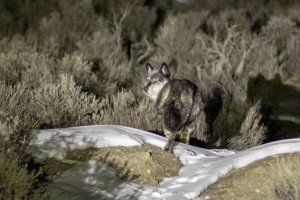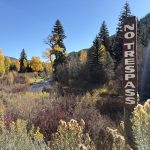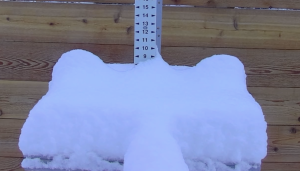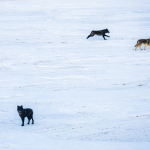Federal official tells Colorado Parks and Wildlife to stop importing Canadian wolves. What happens now?
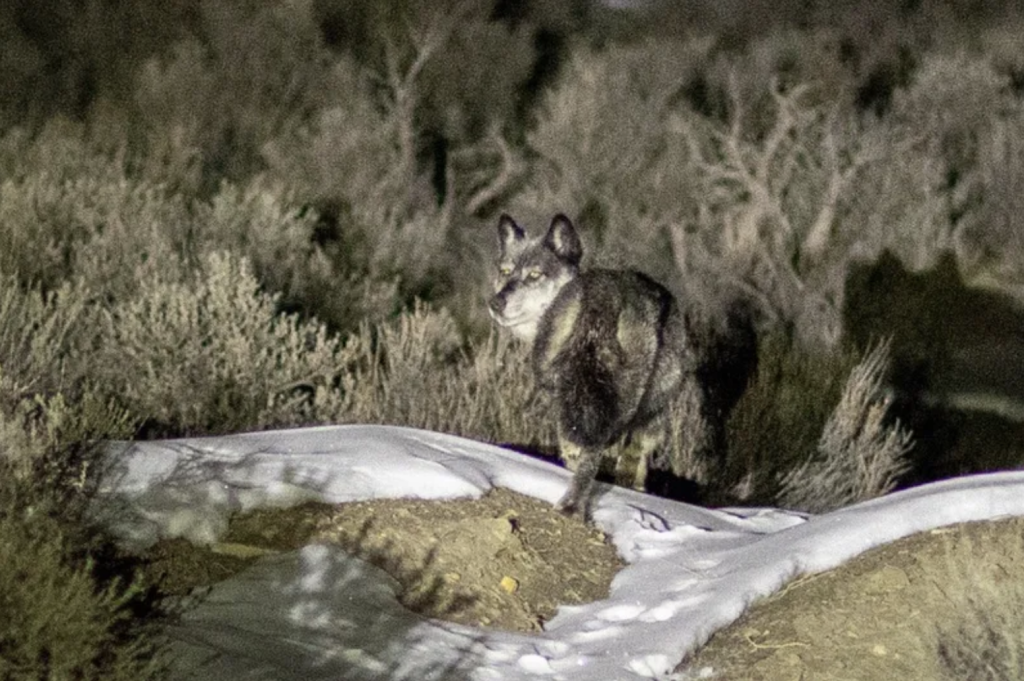
Colorado Parks and Wildlife/Courtesy Photo
Greg Lopez was pleased when he read the recent letter from the U.S. Fish and Wildlife Service directing Colorado Parks and Wildlife to stop importing wolves from Canada.
“When I read it,” said Lopez, who is a Republican gubernatorial candidate for Colorado, “it made sense to me.”
He added that this is what federal agencies are supposed to do: to monitor and ensure that any representative that is acting as an extension of the agency — in this case, Colorado Parks and Wildlife — is operating within its designated parameters.
“Anything outside of those parameters are not authorized or lawful,” he said.
The letter
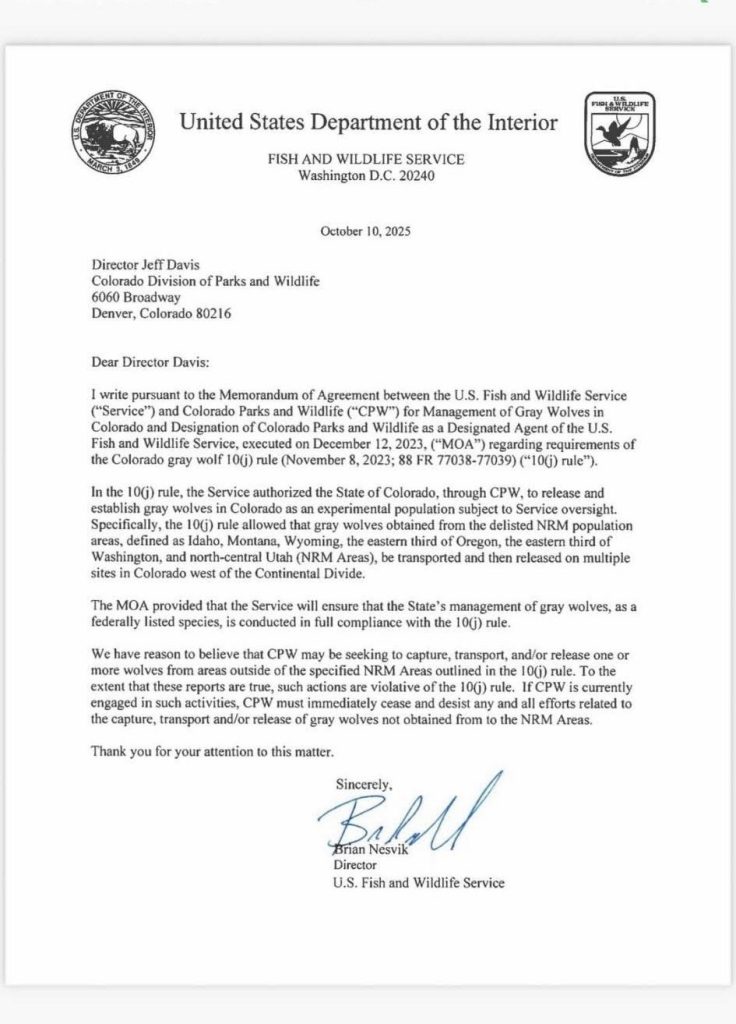
The letter in question is from Brian Nesvik, director of the U.S. Fish & Wildlife Service, who wrote Parks and Wildlife Director Jeff Davis directly, dated Oct. 10, stating that importing Canadian wolves as part of the state’s reintroduction effort would be violating the 10(j) rule.
Nesvik, who was the director of Wyoming’s Game and Fish Department until his retirement in 2024, was nominated by President Donald Trump in February and confirmed in August to his current position.
In Nesvik’s letter to Davis, he wrote, “the 10(j) rule allowed that gray wolves obtained from the delisted (Northern Rocky Mountain) population areas, defined as Idaho, Montana, Wyoming, the eastern third of Oregon, the eastern third of Washington, and north-central Utah (NRM Areas), be transported and then released on multiple sites in Colorado west of the Continental Divide.”
“We have reason to believe,” Nesvik’s letter continued, “that CPW may be seeking to capture, transport, and/or release one or more wolves from areas outside of the specified NRM Areas outlined in the 10(j) rule.”
Such actions, he wrote, violate this rule.
“If CPW is currently engaging in such activities,” he warned, “CPW must immediately cease and desist any and all efforts related to the capture, transport and/or release of gray wolves not obtained from to (sic) the NRM Areas.”
In response to the letter, Rachael Gonzales, Parks and Wildlife’s Northwest Region public information officer, stated in an email that “CPW continues to evaluate all options to support this year’s gray wolf releases in alignment with the approved Colorado Wolf Restoration and Management Plan and the 10(j).”
Gonzales brought up the fact that the state agency has a Memorandum of Understanding as well as a recently signed contract with British Columbia’s Minister of Water, Land, and Resource Stewardship — both agreements of which allow the state agency to translocate 10-15 wolves this winter in partnership with British Columbia.
“This MOU, as well as last year’s partnership,” she wrote, “were based on consultations with USFWS and were signed before the letter from (Nesvik) was received.
“CPW has coordinated with USFWS throughout the gray wolf reintroduction effort and has complied with all applicable federal and state laws.”
What likely initiated Nesvik’s letter
Back in June of this year, Lopez was approached by an outfitter association that asked him to attend a meeting in Glenwood Springs held by the Parks and Wildlife Commission where discussion about the reintroduced wolves and depredation was occurring.
“Talking to some of the ranchers about their concerns and hearing the nervousness in their voice, their uncertainty in their eyes,” he said, “they asked me if I would please look into it, see what I could do to help them kind of slow down the reintroduction.”
In addition to attending more meetings, he read over the Colorado Wolf Restoration and Management Plan, the 10(j) rule, and the Endangered Species Act.
“After looking at all that,” he said, “it is evident to me that the most logical thing to do is to just pause and take a break to bringing in more wolves into Colorado until we are able to manage the wolves that we currently have.”
With the backing of over two dozen organizations across the state — ranging from cattlemens’ associations, wool growers’ associations, county farm bureaus, Colorado Counties Inc., and Club 20 — help was sought in the form of a letter dated Sept. 9 to U.S. Fish and Wildlife Service’s Regional Director Matt Hogan, Mountain-Prairie Region. Specifically, Lopez — along with Jennifer Burbey, president of the Colorado Outfitters Association; and Bonnie Eddy, executive director of the Colorado Wool Growers Association — asked for a “cease-and-desist order halting further translocation of wolves into Colorado for a period of 12 months.”
“It was the first time that I am aware of that anyone had reached out to the U.S. Fish and Wildlife Service,” Lopez said. “Most organizations, the cattle associations, and so forth were dealing directly with Colorado Parks and Wildlife.
“I believe that was a true result of that letter, that Director Brian Nesvik notified the state of Colorado that they must stay within the terms and conditions of the permit.”
A legal interpretation
Kelly Nokes — an attorney with the Western Environmental Law Center who focuses primarily on Endangered Species Act and public lands litigation in the region and in Colorado — reviewed this new legal interpretation in the letter with curiosity.
“I’d be curious to know what the citation is for U.S. Fish and Wildlife Service’s assertion that the wolves have to come from the Northern Rocky Mountains in the management plan,” she said. “I don’t think the plan limits CPW to just the Northern Rocky states.”
The Colorado Wolf Restoration and Management Plan references how Parks and Wildlife will go about procuring wolves for the reintroduction effort:
— “It is desirable to source wolves from the Northern Rockies States (Idaho, Montana, and Wyoming) or other suitable donor sites (Oregon, Washington, as recommended by the TWG) with assistance from other state wildlife management agencies.” (p. ii)
— “This wolf reintroduction effort will be undertaken by CPW in co-operation with Federal agencies, potentially affected Tribes, and the states of Idaho, Montana and/or Wyoming from which wild wolves will be transferred via agreement. Specific agreements regarding donor populations have been discussed with these three states but final agreements have not yet been concluded. In the event that none of these three states can serve as source sites for wolf donor populations, CPW has also begun to explore an agreement with the states of Washington and/or Oregon.” (p. 20)
In the end, though, Nokes added, it is the 10(j) rule that is the legally controlling rule for managing wolves in Colorado.
“There is no limitation in that section 10(j) rule that says that source populations has to be from one of these six Northern Rocky states (RE: outlined in Nesvik’s letter) — that’s just not in the rule,” she said.
She believes that Parks and Wildlife’s intention was to obtain its source population from those six areas, but, outside of Oregon, the others refused to help Colorado. So the state agency had coordinated and consulted U.S. Fish and Wildlife Service to bring wolves from Canada, as noted by Gonzales. The federal agency knew what was happening and were okay with it. But the administration changed, and a new director was confirmed.
“I think CPW is really being put in a tough spot right now,” she said. “They’re trying to do the right thing and trying to do this in a manner that’s fair for everybody — and now there is this new legal interpretation that’s coming out. I wouldn’t be surprised if it does end up in the courts.”
Moving forward
The U.S. Fish and Wildlife Service, Lopez said, worked with Parks and Wildlife to honor the result of the successful passage of Proposition 114, that the people of Colorado wanted a thriving population of gray wolves, starting in December of 2023.
“U.S. Fish and Wildlife Service, in their processes, classified the wolf as a nonessential, experimental population,” he said. “This is an experiment that U.S. Fish and Wildlife Service was willing to conduct to see if the wolf could in fact co-exist here in Colorado.”
He stressed that the state agency must follow the rules of 10(j) and make sure the reintroduction is done correctly.
“There is nothing wrong with doing a pause, and there is nothing wrong in admitting if in fact the experiment has failed and it will not be able to be fulfilled,” he said. “But that is a discussion that needs to be continuously discussed.
“I think what everybody wants to do is give the wolf a fair opportunity — and right now, they’re playing politics with the wolf.”

Support Local Journalism

Support Local Journalism
Readers around Glenwood Springs and Garfield County make the Post Independent’s work possible. Your financial contribution supports our efforts to deliver quality, locally relevant journalism.
Now more than ever, your support is critical to help us keep our community informed about the evolving coronavirus pandemic and the impact it is having locally. Every contribution, however large or small, will make a difference.
Each donation will be used exclusively for the development and creation of increased news coverage.
